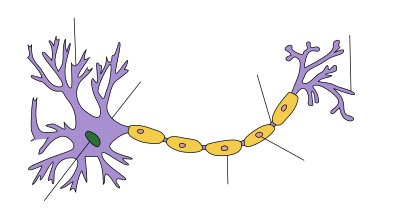Medullary sheath
| Myelin sheath |
|---|
Myelin is a fatty white substance that surrounds the axon of some nerve cells, forming an electrically insulating layer. It is essential for the proper functioning of the nervous system. It is an outgrowth of a type of glial cell.
The production of the myelin sheath is called myelination or myelinogenesis. In humans, myelination begins early in the 3rd trimester, although little myelin exists in the brain at the time of birth. During infancy, myelination occurs quickly, leading to a child's fast development, including crawling and walking in the first year. Myelination continues through the adolescent stage of life.
Schwann cells supply the myelin for the peripheral nervous system, whereas oligodendrocytes, specifically of the interfascicular type, myelinate the axons of the central nervous system. Myelin is considered a defining characteristic of the (gnathostome) vertebrates, but myelin-like sheaths have also been seen in some invertebrates, although they are quite different from vertebrate myelin at the molecular level. Myelin was discovered in 1854 by Rudolf Virchow.
Myelin comprises different cell types and varies in chemical composition and configuration but performs the same insulating function. Myelinated axons are white; hence, the "white matter" of the brain. Myelin insulates axons from electrically charged atoms and molecules. These charged particles (ions) are found in the fluid surrounding the entire nervous system. Under a microscope, myelin looks like strings of sausages.
Cholesterol is an essential component of myelin, which comprises about 40% water; the dry mass comprises between 60% and 75% lipids and between 15% and 25% proteins. Myelin basic protein (MBP) constitutes ~23% of myelin protein,myelin oligodendrocyte glycoprotein, and proteolipid protein (PLP, which makes up ~50% of myelin protein). The primary lipid of myelin is a glycolipid called . The intertwining hydrocarbon chains of sphingomyelin strengthen the myelin sheath. In brain, the myelin sheath covers the fibers of the corpus callosum, which constitute the inner part of the cerebral hemisphere.
...
Wikipedia

